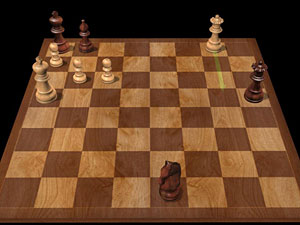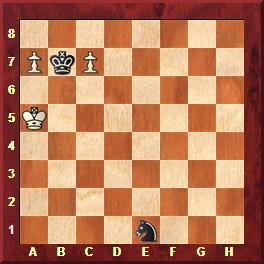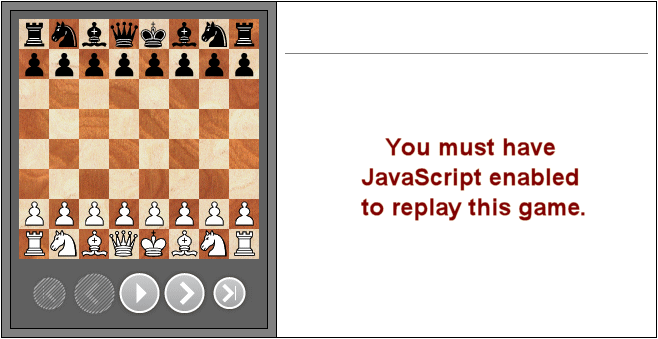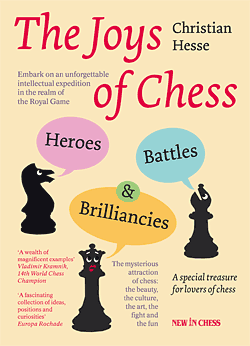


Lovely chess moves and lovely melodies and lovely theorems in mathematics have this in common; every one has idiosyncratic nuances that seem logical a posteriori but that are not easy to anticipate a priori. – D. R. Hofstadter
He lived on Cosmonaut Avenue, next to the subway station Zvezdnaya. I have no doubt that he arrived from another world, and I was not at all surprised when Grandmaster Yudasin one day said that Leopold Mitrofanov was a newcomer from outer space. He drew his conclusion upon considering Mitrofanov’s astonishing, fantastic studies. – V. Fedorov
If you take a look at the following position and try to relate to it, it may well be that you consider it basic and boring.
Leopold Mitrofanov
1.p Rustaveli MT Vecherni Tbilisi 1967

White to play and win
The evaluation appears clear. Black’s oppressive superiority is based on a series of factors. He has three more pieces and can rejoice in a pawn that is only one step away from promotion. White, on the other hand, is quite without pieces and his pawns are a long way from aspiring to higher rank. The variation 1.g7? Nc4+ 2.Ka4 Nb6+ 3.Kb3 (3.Ka5 Nc2 4.g8Q Bb4#) 3...h1Q 4.g8Q Qf3+ 5.Ka2 Qa3+ 6.Kb1 Qb3+ 7.Kc1 Qc2 with mate, demonstrates in addition that White cannot even count on getting a pawn on to the 7th rank in a favourable fashion. So it does not matter whose move it is, the judgment on the above position seems absolutely beyond a shadow of a doubt: far and wide we can see no way for White to do anything other than to bow honourably to the inevitable and resign. No matter which way our brain may twist and turn, our thought processes always end up in a blind alley.
But, incredibly, the stipulation under the position reads White to play and win. This circumstance alone causes a sudden about-turn and makes the study quite extraordinarily interesting. And it is obvious that it will take something sensational in chess terms to reverse everything that our experience tells us is impossible. This something will include what is perhaps the most spectacular move ever thought of in chess. In any case the move would be my nomination for any such competition. This move has turned the study into one of the most famous of all chess composition.
The solution (which you can replay on the JavaScript board below, starts with 1.b6+, which is still in line with what one might expect, because the queenside pawns represent the only spark of hope for White. 1...Ka8! 2.g7. With the king on the eighth rank, this is the only move after which White is not rapidly mated. 2...h1Q 3.g8Q+ Bb8 4.a7. Once again the only move which does not lose. White is even threatening mate, but his king is badly placed and Black can work up an attack with his troops. 4...Nc6+. Sacrificing to gain a few checks. White can do nothing but accept it: after 5.Ka6 there comes 5...Qf1#, after 5.Ka4 Qe4+ White is also mated in a few moves, and after 5.Kb5 Nd3 6.axb8Q+ Nxb8 7.b7+ Ka7! 8.Qe6 Qb1+ 9.Kc4 Nd7 10.b8Q+ Kxb8 11.Qd6+ Kc8 12.Qc6+ Kd8 13.Qa8+ Ke7 14.d6+ Kxd6 Black is winning. 5.dxc6 Qxh5+, and this is the second check which Black gained with his sacrifice 4...Nc6+.

White has played well and transformed the situation which appeared hopeless at the start into a position which now looks drawish. But who would imagine that White could win? Just consider these continuations:
In every case a draw. However, White is looking for more than just a draw. But what else is there for him to bring this about? There is the apparently impossible 6.Qg5!!!
What an idea!! A move to which an entire book was dedicated: Mitrofanov’s Deflection by IM Viktor Charuschin took this move as its subject. A move not yet seen by humanity. A move from another world. It has gone down in the annals of chess as Mitrofanov’s deflection. A beautiful, profound, quiet move, a gentle and subtle nuance. White abandons his own threats of mate, sacrifices his queen for no apparent compensation and in doing so takes on a check and a massive material minus.
But after careful analysis, it becomes clear that the move has brought about a tiny change. It does achieve a deflection, though only a microscopic one, of the black queen on to a less favourable square, namely a dark square. It is fascinating how this minute change to the actual state of affairs makes the difference between a draw and victory. When you realise this, it feels like an epiphany.
Now: 6...Qxg5+ 7.Ka6! After this move, once more the only one not to lose, there is an extremely sudden change in the fate of the game: it is now Black who goes down, quickly and surprisingly. The white pawns unexpectedly prove stronger than the three powerful black pieces. Black can still try 7...Qa5+! 8.Kxa5 Bxa7 9.c7!! Kb7 10.bxa7 or even the move order 7...Bxa7 8.c7 Qa5+ 9.Kxa5 Kb7 10.bxa7, but all to no effect as far as he is concerned. This is what the final set-up looks like:

A trick and a masterpiece at one and the same time. Even the final position is beautiful to look at. Long may its banner gloriously wave!
A little bit of finishing off still needs doing. We have to work out what function the knight is fulfilling on e1. Without it, Black would have set up a stalemate with 6.Qg5 Qxg5+ 7.Ka6 Bxa7 8.c7 Qa5+! 9.Kxa5 Bxb6+ 10.Kxb6 and thus got a draw. So this detail falls into place too.

[Event "1.p Rustaveli MT Vecherni Tbilisi (c)"] [Site "?"] [Date "1967.??.??"] [Round "?"] [White "Mitrofanov, Leopold"] [Black "White to play and win"] [Result "1-0"] [SetUp "1"] [FEN "8/k7/P2b2P1/KP1Pn2P/8/8/7p/4n3 w - - 0 1"] [PlyCount "19"] [EventDate "1967.??.??"] 1. b6+ (1. g7 $2 Nc4+ 2. Ka4 Nb6+ 3. Kb3 (3. Ka5 Nc2 4. g8=Q Bb4#) 3... h1=Q 4. g8=Q Qf3+ 5. Ka2 Qa3+ 6. Kb1 Qb3+ 7. Kc1 Qc2#) 1... Ka8 2. g7 h1=Q 3. g8=Q+ Bb8 4. a7 Nc6+ 5. dxc6 (5. Ka6 Qf1#) (5. Ka4 Qe4+ {and White is mated in a few moves.}) ({After} 5. Kb5 Nd3 6. axb8=Q+ Nxb8 7. b7+ Ka7 $1 8. Qe6 Qb1+ 9. Kc4 Nd7 10. b8=Q+ Kxb8 11. Qd6+ Kc8 12. Qc6+ Kd8 13. Qa8+ Ke7 14. d6+ Kxd6 {Black is winning.}) 5... Qxh5+ {[#]} 6. Qg5 $3 (6. Ka4 Qd1+ 7. Qb3 Qa1+ 8. Kb5 Qe5+ 9. Ka6 Qa1+ $11) (6. Kb4 Qh4+ 7. Kb5 Qh5+ 8. Kc4 Qe2+ 9. Kb4 Qb2+ $11) (6. Ka6 Qe2+ 7. Ka5 Qe5+ 8. Ka4 Qd4+ 9. Kb5 Qe5+ $11) 6... Qxg5+ 7. Ka6 $1 Qa5+ $1 ( 7... Bxa7 8. c7 Qa5+ 9. Kxa5 Kb7 10. bxa7 $18) 8. Kxa5 Bxa7 9. c7 $3 Kb7 10. bxa7 $18 1-0
There is a follow-up question: has anything as fantastic as Mitrofanov’s deflection ever been successfully employed in over-the-board chess, at least in rudimentary fashion? That is the subject of our next installment.
 The Joys of Chess is an unforgettable intellectual expedition to the remotest corners of the Royal Game. En route, intriguing thought experiments, strange insights and hilarious jokes will offer vistas you have never seen before.
The Joys of Chess is an unforgettable intellectual expedition to the remotest corners of the Royal Game. En route, intriguing thought experiments, strange insights and hilarious jokes will offer vistas you have never seen before.
The beauty, the struggle, the culture, the fun, the art and the heroism of chess – you will find them all in this sparkling book that will give you many hours of intense joy.
Christian Hesse is a Harvard-trained professor of Mathematics who has taught at the University of California, Berkeley (USA), and since 1991 at the University of Stuttgart. He has written a textbook called 'Angewandte Wahrscheinlichkeitstheorie'.
Chess and literature are his main hobbies, and he also likes fitness and boxing. His heroes are the ones who fall to the bottom and rise again, fall and rise again…
From the foreword by World Champion Vishy Anand: "A rich compendium of spectacular highlights and defining moments from chess history: fantastic moves, beautiful combinations, historical blunders, captivating stories, and all this embedded into a plentitude of quick-witted ideas and contemplations as food for thought."